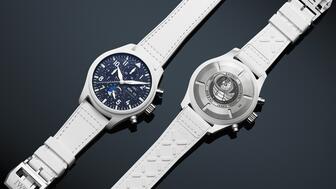Said to be the first to write a jewelry sales manual for the industry, Zell is remembered for his zest for life.
7 Charged with Selling Fake Native American Jewelry
The defendants allegedly produced the pieces in a factory in the Philippines but were passing them off as authentic Native American-made jewels.
Phoenix—Seven people have been indicted for allegedly importing jewelry from the Philippines and selling it as authentic Native American-made pieces.
According to the U.S. Department of Justice, a federal grand jury returned a 38-count indictment on Feb. 26 against suspects based in both the Philippines and United States.
The indictment accuses them of operating a fraudulent scheme to import Native American-style jewelry into the U.S. from the Philippines and sell it to retail stores and individuals across the Southwestern U.S. as authentic jewelry made by Native Americans.
The fraud and money laundering scheme started in January 2016, the Justice Department said, and violated federal laws including the Indian Arts and Crafts Act. The IACA prohibits the display or sale of any goods that falsely suggest they are Native American-produced, a Native American product or the product of a particular Native American and/or Native American tribe.
Richard Dennis Nisbet, 70, and his daughter, Laura Marye Lott, 31, both of Peoria, Arizona, are named in the indictment as the pair who were overseeing the scheme.
The defendants allegedly took several measures to ensure the jewelry resembled authentic Native American-made jewelry, including copying designs from genuine Native American artists, using traditional Native American motifs and symbols, and stamping the jewelry with the initials of Native American artists.
Court documents state the jewelry was imported into the U.S. through FedEx, or smuggled into the country by hand or through the Philippines Postal System to locations in Arizona, with Lott delivering the pieces to retail stores in Arizona, Texas and other states and collecting payment.
The indictment also names Christian Coxon, 45, owner and operator of the Turquoise River Trading Company jewelry store in San Antonio, Texas, which claims to specialize in Native American-made jewelry; and Waleed Sarrar, 43, of Chandler, Arizona, owner and operator of Scottsdale Jewels in Arizona, which also advertises “authentic Indian-made jewelry” for sale.
According to court documents, Coxon and Sarrar conspired with Nisbet and Lott to pass off the imitation jewelry as authentic Native American-made jewelry.
Court documents also allege that none of the jewelry items were indelibly marked with the country of origin, as U.S. customs law requires.
None of the calls placed to the U.S.-based defendants by National Jeweler on Monday were answered or returned.
The indictment also names three international defendants who have been charged in the case: Mency Remedio, a factory manager in the Philippines;
The Latest

The company outfitted the Polaris Dawn spaceflight crew with watches that will later be auctioned off to benefit St. Jude’s.

A buyer paid more than $100,000 for the gemstone known as “Little Willie,” setting a new auction record for a Scottish freshwater pearl.

Supplier Spotlight Sponsored by GIA.

Anita Gumuchian created the 18-karat yellow gold necklace using 189 carats of colored gemstones she spent the last 40 years collecting.


The giant gem came from Karowe, the same mine that yielded the 1,109-carat Lesedi La Rona and the 1,758-carat Sewelô diamond.

The three-stone ring was designed by Shahla Karimi Jewelry and represents Cuoco, her fiancé Tom Pelphrey, and their child.

Supplier Spotlight Sponsored by GIA

The Manhattan jewelry store has partnered with Xarissa B. of Jewel Boxing on a necklace capsule collection.

Acting as temporary virtual Post-it notes, Notes are designed to help strengthen mutual connections, not reach new audiences.

The jewelry historian discusses the history and cultural significance of jewelry throughout time and across the globe.

From fringe and tassels to pieces that give the illusion they are in motion, jewelry with movement is trending.

The designer and maker found community around her Philadelphia studio and creative inspiration on the sidewalks below it.

The change to accepted payment methods for Google Ads might seem like an irritation but actually is an opportunity, Emmanuel Raheb writes.

The industry consultant’s new book focuses on what she learned as an athlete recovering from a broken back.

The fair will take place on the West Coast for the first time, hosted by Altana Fine Jewelry in Oakland, California.

Hillelson is a second-generation diamantaire and CEO of Owl Financial Group.

Submissions in the categories of Jewelry Design, Media Excellence, and Retail Excellence will be accepted through this Friday, Aug. 23.


Known as “Little Willie,” it’s the largest freshwater pearl found in recent history in Scotland and is notable for its shape and color.

Clements Jewelers in Madisonville cited competition from larger retailers and online sellers as the driving factor.

The gemstone company is moving to the Ross Metal Exchange in New York City’s Diamond District.

The Pittsburgh jeweler has opened a store in the nearby Nemacolin resort.

With a 40-carat cabochon emerald, this necklace is as powerful and elegant as a cat.

The Erlanger, Kentucky-based company was recognized for its reliability when it comes to repairs and fast turnaround times.

Unable to pay its debts, the ruby and sapphire miner is looking to restructure and become a “competitive and attractive” company.

The trend forecaster’s latest guide has intel on upcoming trends in the jewelry market.

Ingraham said she’ll use the scholarship funds to attend the Women’s Leadership Program at the Yale School of Management.



























